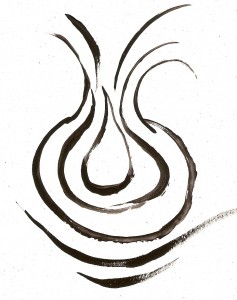Meditation has been defined as the mind and body settling into stillness. Often, however, when we sit to meditate, stillness seems far away. There are the sounds of people in the hallway, or the phone ringing, or birds singing outside. And then there are thoughts . . . . Sometimes when we close our eyes to meditate it seems as though the mind gets going faster than it was before.
Many people take these experiences of mental activity as signs of their lack of readiness for the “discipline” of meditation, or as signs of the inadequacy of the technique. After a few tries at meditating they give up, saying, “I guess jogging is a better way for me to relax.” We need not be so discouraged.
 It is the nature of the mind to think. Frank Smith, a leading researcher in the field of reading instruction, says that just as the function of the lungs is to breathe, the function of the brain is to think. Boredom and confusion, he suggests, are as anathema to the brain as suffocation is to the lungs. So of course the mind wants to think about something when we close our eyes to meditate.
It is the nature of the mind to think. Frank Smith, a leading researcher in the field of reading instruction, says that just as the function of the lungs is to breathe, the function of the brain is to think. Boredom and confusion, he suggests, are as anathema to the brain as suffocation is to the lungs. So of course the mind wants to think about something when we close our eyes to meditate.
The point of meditation is not to stop the mind from thinking. Rather, meditation trains the mind to think more and more quietly, so that we can experience more refined levels of awareness. Saints and mystics tell us that the most refined level of awareness is silence – not a dulling of the mind, but more like a sharpening of the mind, a heightening of alertness. They use words like “liveliness,” “pure awareness,” and “creative intelligence” to describe this inner peace.
How do we even begin to experience such refinement? How do we cope with the perpetual stream of consciousness that seems to keep us at more excited levels of thinking? The somatic approach suggests two pillars of successful practice: relaxation and attention.
1. RELAXATION
 Start by relaxing your body. Tai Chi, yoga, massage, and other somatic arts offer a wealth of exercises designed to prime the body and mind for settling into quietness. To the extent that time and space allow, draw from the wellsprings of these traditions. Take a few minutes to stretch, bend, twist, and let go of the tensions of the day. If time and space are limited (for example, riding on the bus or train), you can do simple moves such as this sitting version of the pelvic tilt:
Start by relaxing your body. Tai Chi, yoga, massage, and other somatic arts offer a wealth of exercises designed to prime the body and mind for settling into quietness. To the extent that time and space allow, draw from the wellsprings of these traditions. Take a few minutes to stretch, bend, twist, and let go of the tensions of the day. If time and space are limited (for example, riding on the bus or train), you can do simple moves such as this sitting version of the pelvic tilt:
As you breathe in, open the chest and arch the back ever so slightly. On the out-breath, tuck the tailbone under slightly and let the abdomen sink in. Breathe slowly, deeply, and comfortably this way, 3 to 10 times.
2. ATTENTION
Relaxing prepares you for meditation, but it is not meditation itself. For the mind to settle into stillness, yet remain alert, there must be some focus to your awareness. The aim of somatic meditation is to sustain your focus in an easeful manner.
As observed earlier, the mind needs to think about something. According to the law of substitution, the mind cannot think of more than one thing at once. When we think of one thing, the mind by necessity will not be thinking of something else. Meditation makes use of the law of substitution by giving your mind something to think about in a relaxed state. One thing we can give the mind to think about is our breath.
Dwelling with the experience of the breath is a classic meditation technique, and is now taught in a variety of settings, including schools and hospitals. It is one of the simplest ways to meditate somatically. Many students have found this technique useful for going to sleep at night. These guidelines may help:
Begin by lying down or sitting comfortably upright – any position that will allow you to relax to your maximum. Let your breath be the focus of your awareness, easily and without effort. Simply notice what happens in your body as you breathe in and breathe out. You may find that your attention shifts among different aspects of the breath, such as sensations in the nose or other respiratory passageways, or sensations deep within your center. Your breath may alter slightly during this period of focused awareness, getting deeper or shallower, longer or shorter. Simply dwell innocently with the experience of these changes, neither forcing nor resisting change.
 When your mind drifts, gently let it return to your breath. This drifting may occur several times during your practice. If you like, look at every time that you remember to come back to your breathing as another step in your developing ability to maintain focus in a quiet state. Or you may, without comment, simply return to your awareness on the breath.
When your mind drifts, gently let it return to your breath. This drifting may occur several times during your practice. If you like, look at every time that you remember to come back to your breathing as another step in your developing ability to maintain focus in a quiet state. Or you may, without comment, simply return to your awareness on the breath.
Continue this way for five, ten, even twenty minutes. When it is time to end meditation, take a few minutes before coming out slowly. You can stretch, slowly turn your head from side to side, rub your palms together and place them gently over your eyes . . . or just sit easily with your eyes closed. Then, after a couple of minutes, slowly open your eyes.
 The purpose of meditation is not only to rest the mind and gain a temporary respite from the work and challenges of the day. It is also to bring a sense of peace and perspective into activity. One of the most important steps of successful meditation, then, is to come out as somatically as you do the practice itself – with awareness of the body’s sensations and respect for its readiness for activity. Take a few minutes to slowly return to activity. “In your easy pace you will accomplish double.”
The purpose of meditation is not only to rest the mind and gain a temporary respite from the work and challenges of the day. It is also to bring a sense of peace and perspective into activity. One of the most important steps of successful meditation, then, is to come out as somatically as you do the practice itself – with awareness of the body’s sensations and respect for its readiness for activity. Take a few minutes to slowly return to activity. “In your easy pace you will accomplish double.”
Text by Stuart Moody (copyright 2012)
Illustrations by Alan Scofield, founding director, Young Imaginations (copyright 2011)
